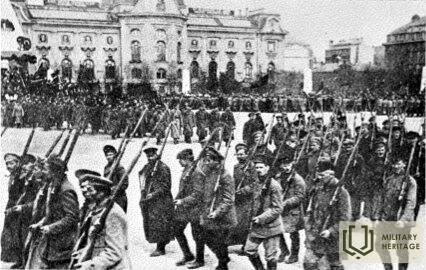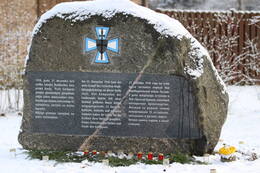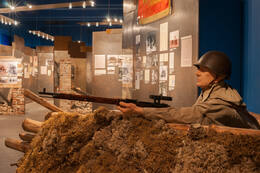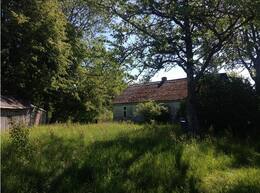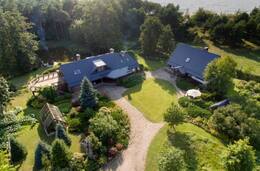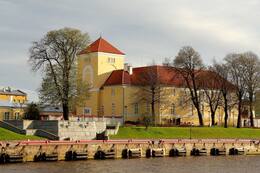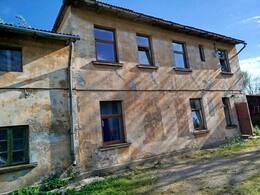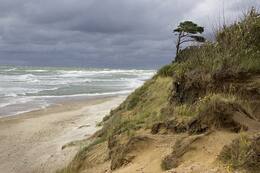Raudonoji armija užėmė Rygą
I Nepriklausomybės karai
1918 m. gruodžio pabaigoje Raudonoji armija priartėjo prie Rygos iš šiaurės, rytų ir pietų. 2-osios latvių šaulių brigados pulkai veržėsi iš Cėsių į Rygą, o abiem Dauguvos krantais – 1-oji latvių šaulių brigada ir Rusijos 2-osios Novgorodo šaulių divizijos pulkai. Paskutinis nesėkmingas bandymas sustabdyti Raudonąją armiją prie Rygos vartų įvyko metų sandūroje prie Inčukalno. Čia Landesvero kuopa kartu su Geležine brigada (taip buvo pavadinti vokiečių kariuomenės daliniai, sutikę kovoti su bolševikus) ir Rusijos antibolševikiniai daliniai patyrė sunkų pralaimėjimą per dvi dienas trukusias kovas prieš 1-ąjį ir 4-ąjį latvių šaulių pulkus.
Blėsdama viltims sustabdyti Raudonosios armijos artėjimą ir jos „raudonuosius“ latvių šaulius, K. Ulmanio vadovaujama Laikinoji vyriausybė, lydima Studentų kuopos, 1919 m. sausio 2 d. vidurdienį išvyko iš Rygos. Sausio 3-iosios rytą miestą paliko ir likę valdžiai ištikimi nacionaliniai kariniai daliniai – iš viso apie 400 karių, vadovaujamų pulkininko Oskaro Kalpako. Didžioji dalis naujai suformuotos nacionalinės kariuomenės dezertyravo, nes nenorėjo kautis prieš „raudonuosius“ latvių šaulius. Rusijos komunistų skaičiavimas įtraukti Latvijos sovietų šaulių diviziją į invaziją į Baltijos šalis pasiteisino. Iš miesto taip pat pasitraukė anglų karo laivai ir keli tūkstančiai pabėgėlių.
Sausio 2-osios naktį Rygoje prasidėjo ginkluotas bolševikų sukilimas. Visą naktį ir iki sausio 3-osios mieste vyko chaotiški susirėmimai tarp bolševikų kovotojų, plėšikų gaujų ir mieste likusių antibolševikinių jėgų dalinių. Miesto kalėjimo prižiūrėtojai pabėgo ir šimtai kalinių buvo paleisti (vien iš Terminiaus kalėjimo 600 žmonių). Per susirėmimus su Geležine brigada ir kai kuriais Landesvero daliniais prie Rygos geležinkelio stoties, lifto ir Antrojo miesto teatro (dabar Latvijos nacionalinis teatras) žuvo 22 žmonės.
1919 m. sausio 3 d. popiet į Rygą įžengė pirmosios šaulių kavalerijos žvalgų grupės. Po pietų ir vakare į miestą įžengė 6-asis latvių šaulių pulkas, atsiųstas iš Valkos. Sausio 4-osios naktį Pēterio Stučkos vadovaujama laikinoji sovietų vyriausybė traukiniu atvyko prie sugriauto Juglos tilto. Jos nariai įsėdo į iš vokiečių nelaisvę šarvuotą traukinį ir naktį įvažiavo į Rygą. Jau trečią valandą ryto sovietų valdžios atstovai dalyvavo Rygos karo revoliucinio komiteto, vadovavusio bolševikų vadovaujamam sukilimui, posėdyje. Rygoje prasidėjo bolševikų valdžia, trukusi nepilnus penkis mėnesius.
Daugiau informacijos šaltinių
Sielų pūga. „Raudonieji“ šauliai įžengia į Rygą. Galima: https://www.dveseluputenis.lv/lv/laika-skala/notikums/106/sarkanie-strelnieki-ieiet-riga/ [žiūrėta 2021 05 06].
Susijusi laiko juosta
Susijusios vietos
Monument to the first battle for Latvia's independence
Atroadas, Inčukalns, Atmodas Street 2.
On July 3, 2016, a monument to the first battle for Latvia's independence, dedicated to the Latvian National Guard (Die Lettländische Landeswehr), was unveiled. sides. Eižens Upmanis, the chairman of the Brothers' Cemetery Committee, concluded at the time that this could be the historically first monument to the combined Latvian and Baltic forces in the battle memorials outside the cemetery. At that time, Lieutenant Colonel Oskars Kalpaks was appointed commander of the Latvian units of the Latvian National Guard or Landesver, from whose units the later Latvian army grew and formed during the Freedom Fights.
In 1918, the entire territory of present-day Latvia had fallen into the hands of the German Empire and its troops. However, at the end of the summer and autumn of 1918, the situation began to end badly for Germany, and it was clear that it was only a matter of time before Germany would be forced to concede defeat in World War I. The Russian Empire, which included Latvia before World War I, had ceased to exist earlier, with the revolutions of February and October 1917. On November 18, 1918, the Republic of Latvia was proclaimed. After the ceasefire with the Entente on November 11, 1918, the German army, which was on the territory of Latvia, was no longer motivated for further warfare, and most of its soldiers simply wanted to return home.
Under such circumstances, it was clear that Latvia's defense depended primarily on the national guard formed by the people of Latvia. Initially, due to their education and relatively greater ability to self-organize, the greatest initiative in creating such a national guard was shown by the Baltic Germans living in Latvia. Russian soldiers also joined the National Guard. In order to ensure the supply of the National Guard with uniforms, weapons and other necessary resources, on December 7, 1918, the Provisional Government of Latvia entered into an agreement with the German representative August Vinnig, providing for the provision of the National Guard from the German army reserves in Latvia. This agreement stated, among other things, that the National Guard, officially known as the Latvian National Guard or in German, the die Lettländische Landeswehr, would be the armed forces of the Republic of Latvia.
Two soldiers of the Latvian Red Rifle Regiment (ie approximately 2,000 to 3,000 soldiers) who had previously experienced in World War I and the Russian Civil War faced the Latvian National Guard. Despite the experience and numerical superiority of the Red Army, the Latvian National Guard held Inčukalns for two days in fierce fighting, until finally, in the evening of January 1, 1919, to avoid siege, was forced to retire, losing 43 dead and several wounded, most of whom was taken captive by the Bolsheviks, where they were killed or died of starvation or disease.
Author: Artis Buks. Material: Boulder. The monument is made of large monolithic stone, which was found in Rolls near Jelgava.
Latvian War Museum
The Latvian War Museum is located in the Old Town not far from the Freedom Monument in a historic defence building called the ‘Powder Tower’. There are 11 exhibits in the museum. There are various weapons, documents, uniforms, awards, badges and other items detailing the everyday life of a soldier in war. The Latvian War Museum is one of the oldest museums in Latvia. Its origins can be found in World War I. Museum’s collection was made up mainly of personal items of soldiers or items found on battlefields. After Latvia gained its independence the main goal of the museum became to create an exposition on the military history of Latvia and the active role of the population in protecting their land. In 1937 the museum was expanded and was technically one of the most modern museums in Europe at that time. The Powder Tower was one of the fortification towers of Riga. Some evidence dates back to 1330 where it has been mentioned as the ‘Sand Tower’. The tower was destroyed in 1621 when Riga was besieged by the Swedish Army. But in 1650 a new tower for storing gunpowder and weapons was built. After the city’s fortifications were taken down, the Powder Tower remains as one of the most important pieces of evidence of the Riga defence system.
"Laukgaļi" house, writer Kārlis Skalbe's place of residence
"Laukgaļi" in Jūrkalne parish, the writer Kārlis Skalbe's place of residence in October-November 1944, while waiting for the refugee boat to Sweden.
"Bambaļi" houses - one of the main places of accommodation for boat refugees
The restored "Bambaļi" houses in Ošvalki, Jūrkalne parish, were one of the main places of settlement for boat refugees on the coast of Kurzeme.
Refugee temporary accommodation "Vārve huts"
Vārves "huts", a place in Ventspils county, which served as a temporary accommodation for Latvian refugees who were waiting for boats from Gotland to arrive in 1944.
Prison in the castle of the Livonian Order during World War II
1944-1945 in the prison set up in Livonia Oden Castle. In 2010, several members of the LCP Ventspils communication group and the movers of refugee boats were detained.
The building in Ventspils, where LCP liaison Valentine Jaunzeme (Lasmane) lived in 1944
House at Lauku Street 4, Ventspils, where the teacher teacher Valentīne Lasmane (b. Jaunzeme) (1916–2018) lived and worked, who in 1944-1945 worked as LCP liaison and member of Ventspils communication group. Lived in Sweden after World War II. She compiled the testimonies of 130 boat refugees in the publication "Across the Sea 1944/1945." (Stockholm, 1990), but V. Lasmane's own life story can be read in the book "The night is not just for sleeping" (Riga, 2020). In 2000, she was awarded the Order of Three Stars. Died at the age of 102 in 2018 in the Stockholm suburb of Tebia.
Staldzene steep bank, from which refugee boats to Sweden were transported in 1944
In 1944, there was an active traffic of refugee boats to the shores of Sweden from Staldzene.
The coast of Mazirbe, from where the refugee boat traffic to Sweden took place in 1944
The coast of Mazirbe was an important place in the Second World War, from where the traffic of refugee boats to Sweden took place in 1944.
Susijusi istorija
Rēzeknes bombardavimas 1944 m
1944 m. Velykas įvyko Rezeknės bombardavimas, dėl to buvo sugriauta didelė dalis miesto pastatų, žuvo dešimtys civilių, o dar keli tūkstančiai liko be pastogės. Žmonės, kurie savo kailiu patyrė šiuos įvykius ir gali apie juos papasakoti, tuo metu buvo tik vaikai. Vienas iš jų yra ir šios istorijos autorius.
Negos upės tilto išgelbėjimas nuo susprogdinimo
Tuo metu, kai 1944 m. vokiečiai traukėsi, buvo susprogdinta daug svarbių objektų ir to išvengti buvo labai sunku, tačiau pasakojama ir apie stebuklingus nutikimus, kai vietos gyventojų drąsa ir kario tolerancija leido išsaugoti vietos gyventojams svarbias vietas, lašiša išliko gyva. Viena iš istorijų yra ši apie diskusiją tarp namų šeimininkės ir vokiečių kareivio, kuris išgelbėjo nuo susprogdinimo visą tiltą.
Pastangos užkirsti kelią Ķegumo HE sprogimui
Antrojo pasaulinio karo metais, kariuomenėms traukiantis, Latvijoje buvo susprogdinta daugybė kariniu ir logistiniu požiūriu svarbių objektų, kad šie ištekliai neliktų priešams. Tokių objektų buvo ir prie Ķegumo, kur vienas svarbiausių objektų yra Ķegumo HE, kuri savo darbuotojų pastangomis ir pastangomis nebuvo visiškai sunaikinta.




